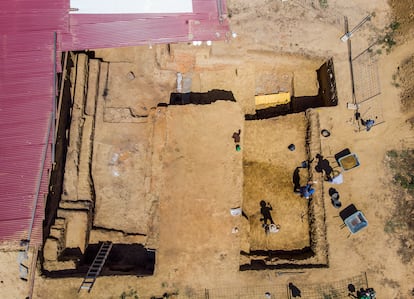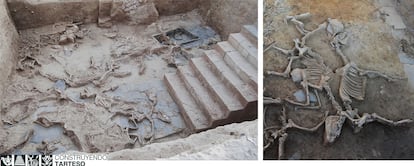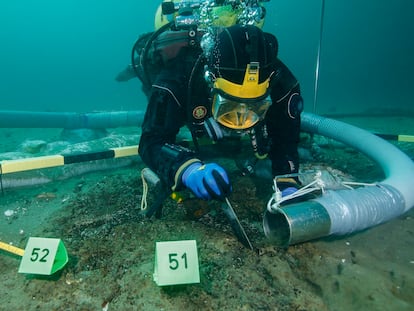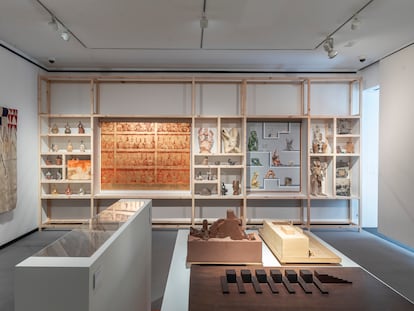The Tartessians sacrificed their most precious animals for years
A study of dozens of horses, bulls and pigs sacrificed in a sanctuary in Tartessos – a historical civilization in the southern Iberian Peninsula – offers clues about what was once the principal civilization of Western Europe

Five years ago, when scientists began excavating at Casas del Turuñuelo — a Tartessian site in the Spanish province of Badajoz — they believed that they were unearthing a hecatomb.
This word means “a great public sacrifice.” The original meaning — which comes from ancient Greek — is the sacrifice of 100 oxen or other victims, which were made to the gods.
At the sanctuary in Tartessos, they haven’t found 100 oxen, but they have found the remains of around 50 animals, especially horses. Today, the in-depth study of all the animals illuminates the relevance of this place for its builders, the Tartessians. But the reasons why Tartessos abandoned this type of sanctuary — like the rest of its constructions — remains a mystery.
The site was discovered in 2014. It was buried under 20 feet of silt and earth, which originate from the nearby Guadiana River. When the archeologists unearthed it the following year, they found a two-story building. “Something like this wouldn’t appear in the western Mediterranean until Roman times, until Pompeii,” says Sebastián Celestino, a researcher at the Institute of Archeology of Mérida (IAM-CSIC) and co-director of the excavation.
Using different dating techniques, the team found that the site was in use in the 5th century BCE — about 2,500 years ago. These were the last days of the Tartessian civilization, born along the coast of what is now Cádiz at the hands of Phoenicians, who came from the eastern Mediterranean and expanded from the Guadalquivir Valley to the Guadiana Valley. For the ancient Greeks, this was the greatest civilization in the West.
While excavating, the scientists discovered a room with an altar in the shape of an ox skin, in which there were decorative elements of either Carthaginian or Greek origin, along with animal remains. As the researchers went deeper into the earth, they first found the remains of two horses at the foot of a staircase, followed by a kind of patio with about 20 animals’ remains. Then, underneath that layer of bones, there were dozens of more beings. About eight years ago, it was believed that they were part of a Greek-style hecatomb and banquet. Now, however, the complete review of all the remains tells a different story.
The results of the archaeozoological study of the bone remains — published in the scientific journal PLOS ONE — have identified 52 animals. The majority are horses (41 of the total) and adult mules, but there are also bovids (bulls and cows), pigs and a dog. But stratigraphic analysis shows that this mass sacrifice didn’t take place during a single hecatomb, but was rather part of a series of rituals carried out in the last years of the building until its abandonment, when it was intentionally sealed.

“At first, to us, the sacrifice seemed to have been made in a single moment,” says Silvia Albizuri, a zooarchaeologist at the University of Barcelona and co-author of the analysis of the animals. “You get there, you see that still photo… and you think that they were all sacrificed [in one shot],” adds María Pilar Iborra, her colleague, who is a researcher at the Valencian Institute of Conservation, Restoration and Research.
“The taphonomic study (the study of the transition of organic matter from the biosphere to the lithosphere) that we’ve done has provided us with information about the history of that deposit, from when it was buried until it was unearthed,” Iborra explains. “The bones collect all that information, everything that has happened to them: if they’ve been sacrificed, if [the animal was] consumed, if they’ve been exposed to the sun. All this information is what has allowed us to conclude that there were three major moments of burial.” The site was a kind of sanctuary in which the Tartessians made sacrifices over the years.”Perhaps for a decade,” Iborra estimates.
The analysis has also shown that the equids were adult males, almost all between the ages of five and eight upon sacrifice. Of the six bovids, four were bulls, while the pig remains belonged to adult sows. Age is key for scientists to rule out that they had been deposited there after a natural death or due to an illness. The thesis of sacrifice gains more strength when one takes into account that both horses and sows were at the peak of their useful life, whether they had been used as pack animals or for breeding. Albizuri — the zooarchaeologist — affirms that such sacrifices “implied an enormous effort for a community.”
Confirmation of ritual sacrifice is evident in the bones from the first two phases of the burial. The two layers were separated by a kind of blanket of about six inches of burnt wheat, which implies that the offerings were made to benefit the fertility of the land. The bones show no marks that would stem from the animals having been dismembered, gutted, or consumed by the humans. Furthermore, the specimens found in the first phase of the burial — the oldest — show that they were exposed to the environment, to the sun and to the wind. “When they made a sacrifice, they didn’t bury [the animal immediately] — first, they wanted the people to see it. It was an exhibition of what had been done and how costly it had been, because they sacrificed animals that were very precious,” Iborra notes.
But in the third phase, something changed. “What we’ve been able to observe in the last phase of storage is that, in addition to the sacrifice of animals, their meat was also consumed. Although not in the cases of the horses: only the cows and a calf. We even detected human bite marks. Then, a banquet would be held, [as] an act of comradery in that last phase,” Iborra explains. Her colleague Albizuri adds: “When we talk about a banquet, we don’t know where the meal took place… but we do know that the leftovers of that meal were left on the patio.”
Iborra says that this was done “to preserve the memory of that act. In fact,” she adds, “in phase three, the calf has all the bones unconnected, with butchery marks, with human bite marks… but all buried together, without anatomical connection. In the Iron Age, these bothros (pits) were very common.” In The Odyssey, Homer described the bothros as holes that were dug, into which drinks for the deities were poured. Victims were sacrificed on top of them.
After that banquet — or shortly afterwards — the Casas del Turuñuelo was buried and the site was abandoned. Neither Iborra nor Albizuri know the reason for this.Neither does the co-director of the excavation: “They sealed it with clay and abandoned it,” Celestino shrugs. However, he notes that there are “13 other Tartessian locations, all intentionally buried and all abandoned at the same time, in the 5th century BCE. Something happened that affected everyone.”
The researchers are now working with geologists and paleoclimatologists to investigate whether the cause could have been a persistent drought or, on the contrary, a succession of rains. With the help of the Palarq Foundation — an NGO that finances archeological endeavors — and the state and regional administrations, the researchers want to unearth more places in Tartessos and continue excavating in the Casas del Turuñuelo. They’re convinced that, beneath the sacrificed animals, there’s something more.
Sign up for our weekly newsletter to get more English-language news coverage from EL PAÍS USA Edition
Tu suscripción se está usando en otro dispositivo
¿Quieres añadir otro usuario a tu suscripción?
Si continúas leyendo en este dispositivo, no se podrá leer en el otro.
FlechaTu suscripción se está usando en otro dispositivo y solo puedes acceder a EL PAÍS desde un dispositivo a la vez.
Si quieres compartir tu cuenta, cambia tu suscripción a la modalidad Premium, así podrás añadir otro usuario. Cada uno accederá con su propia cuenta de email, lo que os permitirá personalizar vuestra experiencia en EL PAÍS.
¿Tienes una suscripción de empresa? Accede aquí para contratar más cuentas.
En el caso de no saber quién está usando tu cuenta, te recomendamos cambiar tu contraseña aquí.
Si decides continuar compartiendo tu cuenta, este mensaje se mostrará en tu dispositivo y en el de la otra persona que está usando tu cuenta de forma indefinida, afectando a tu experiencia de lectura. Puedes consultar aquí los términos y condiciones de la suscripción digital.
More information
Últimas noticias
Welcome to the post-religion era: The idea of Christianity as the absolute truth has become obsolete
‘I thought you would like it’: The risky sexual practice popularized by TV shows and TikTok
The digitalization of tourism: ‘They promise experiences and gave us the worst possible one’
Mexican peso defies uncertainty with forecasts of a new period of stability in 2026
Most viewed
- Sinaloa Cartel war is taking its toll on Los Chapitos
- Reinhard Genzel, Nobel laureate in physics: ‘One-minute videos will never give you the truth’
- Oona Chaplin: ‘I told James Cameron that I was living in a treehouse and starting a permaculture project with a friend’
- Why the price of coffee has skyrocketed: from Brazilian plantations to specialty coffee houses
- Silver prices are going crazy: This is what’s fueling the rally











































